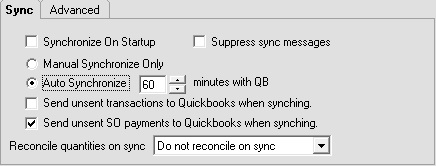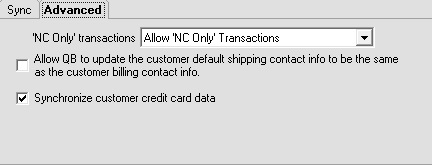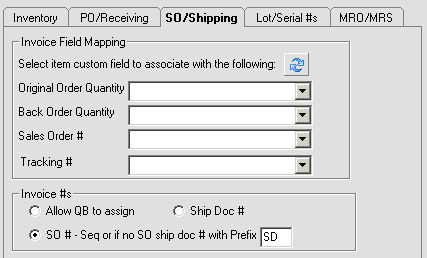Other Resources
As mentioned in our guide to Synchronizing with QuickBooks, the synchronization procedure will let you keep data in both applications up-to-date as you work. This dialog will let you set up a custom synchronization protocol with your QuickBooks file. You originally set part of these preferences when first setting up your New Company File, but this screen will let you adjust those settings as well as set several new options.
At the top of the dialog, you have a few choices regarding the frequency of synchronization.

Selecting Manual Synchronize Only will sync the information only when you specifically command it, whereas clicking Auto Synchronize will bring up a special field enabling you to enter a time interval in minutes (by either typing or clicking the spinner arrows), and the sync will occur repeatedly at that interval for as long as the application is open.
Additionally, you can toggle Synchronize On Startup. When checked, it will automatically synchronize with QuickBooks whenever All Orders is opened, even if the synchronization frequency is set to manual.
To help ensure that QuickBooks has your most recent transactions, choose Send unsent transactions to QuickBooks when synching and Send unsent SO payments to QuickBooks when synching.
If you do not want your sync messages to show up, click Suppress sync messages.
You can also automate the reconciliation process with every sync, if desired. You opt to automatically reconcile to All Orders, to QuickBooks, or not to automatically reconcile at all. For more information on reconciliation, please see Synchronizing with QuickBooks.

On the Advanced Tab, you have a few options for allowing NumberCruncher-only transactions, where the results are not shared with QuickBooks. You can choose to allow these transactions if the user specifies it, disable them entirely, or force all transactions to be NC Only.
You also have the option to Allow QB to update the customer default shipping contact info to be the same as the customer billing info.
All Orders will also Synchronize customer credit card data with Quickbooks if checked.
Below this set of choice, you have a series of four tabs:

The first tab, Inventory, affects how All Order synchronizes your Items. You have just one option here:
Post Inventory Adjustments as Bills in QuickBooks. Normally, inventory adjustments are posted as adjustments with QuickBooks. This, however, requires that QB run in single-user mode. To address this limitation, you can instead post your inventory adjustment as a bill.
Synchronize Manufacturers Part: Check if you want to synchronize part numbers with QB. Note, if you already have part numbers in All Orders they will be overwritten.

On the PO/Receiving tab, you have the following two checkboxes:
Block All Purchase Orders from being sent to QuickBooks. None of your POs are introduced in QB.
Send Receiving Docs to QuickBooks as Item Receipts. Typically, all Receiving Docs introduced into QuickBooks as bills. However, you should desire, you can check this box to send them as item receipts.
Include custom:Job on Bill: Check to record the customer:job on the bill. This will only apply to receivers from linked purchase orders.

The SO/Shipping tab sports four drop-down lists. With them, you can associate an appropriate QuickBooks custom field to each of three All Orders fields that do not have a default QB counterpart. That way, when creating a sales order within QB, you can make sure these elements make it into your All Orders sync. Click the refresh button above the drop downs to load them with the latest available fields from Quickbooks. The Original Order Quantity as well as the Back Order Quantity fields can be mapped to custom item fields within QuickBooks, whereas the Sales Order # and Tracking # can be mapped to a custom customer field.
Invoice #s.
Allow QB to assign
Ship doc #: as invoice ref # if you'd like keep the All Orders ship doc # as part of the information in the corresponding QuickBooks record.
SO # - Seq: This option will use the sales order number a dash '-' and the shipping sequence. For example if you have 2 invoices from the same sales order 787, the invoices #s will be 787-1 and 787-2.

On the Lot/Serial #s tab, you can opt to include serial or lot numbers in the description of Invoices and Bills. When checked, the lot/serial numbers will replace the line items' descriptions, being displayed sequentially as each new line item is created within QuickBooks. You can also chose to append the expiration data to the description.

MRO / MRS
Record manufacturers rep shipment as either a sales receipt or vendor return
Record gross sale and cost of sale as 2 separate line items or as one line item representing the net commission.